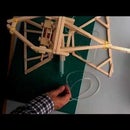Introduction: Electrovalve Tutorial
In this instructable you can see how an electrovalve actually works, how it looks like from the inside and how it can be used in an application that includes a water pump.
In the picture are seen the parts of an electrovalve. The polarity of the battery connection has no effect on the function of the electrovalve (at least mine!).
Attachments
Step 1:
As you can see in this video when we let current pass through the solenoid, it becomes an electromagnet and attracts the permanent magnet downwards (as seen in video), this way in the fully constructed electrovalve acts like a valve that lets the water flow. When the current is off, the magnet is pushed upwards (as seen in video) from spring and closes a hole (passage of water).
Step 2: Electrovalve Driven From a 11.1V Lipo Battery
In this video the electrovalve is connected with a 11.1V lipo battery and as you can see it draws 290mA in order to let the water flow.
Attachments
Step 3: Application: Pump and Electrovalve Connected With the Same Lipo Battery
Getting current at the same time, the pump sends water to the electrovalve and that lets it going through. You could notice that pump works but the water is not seen immediately going out of the electrovalve. This is because the pressure to electrovalve from the the water of the pump needs to get some level so that it could pass through. I had to triple the width of the holes you could see in the introductory picture in order to see some water!















